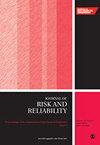Quantification of risk dilution induced by correlation parameters in dynamic probabilistic risk assessment of nuclear power plants
IF 1.8
4区 工程技术
Q3 ENGINEERING, INDUSTRIAL
Proceedings of the Institution of Mechanical Engineers Part O-Journal of Risk and Reliability
Pub Date : 2023-05-06
DOI:10.1177/1748006x231167201
引用次数: 0
Abstract
Nuclear power plants are critical infrastructures that produce electricity. However, accidents in nuclear power plants can cause considerable consequences such as the release of radioactive materials. Therefore, appropriately managing their risk is necessary. Various nuclear regulatory agencies employ probabilistic risk assessment (PRA) to effectively evaluate risks in nuclear power plants. Dynamic PRA has gained popularity because it allows for more realistic assessment by reducing the assumptions and engineering judgments related to time-dependent failure probability and/or human-action reliability in the conventional PRA methodology. However, removing all assumptions and engineering judgments is difficult; thus, the risk analyst, for example, the regulator, must understand their effects on the assessment results. This study focuses on “risk dilution,” which emerges from the assumptions about uncertainty. Dynamic PRA of a station blackout sequence in a boiling-water reactor was performed using the dynamic PRA tool, namely, Risk Assessment with Plant Interactive Dynamics (RAPID) and the severe-accident code Thermal–Hydraulic Analysis of Loss of Coolant, Emergency Core Cooling, and Severe Core Damage version 2 (THALES2), which altered the correlation parameters among the uncertainties of the events that occurred in sequence. The results demonstrated that the conditional core-damage probability and mean value of the core-damage time varied from 0.27 to 0.47 and from 7.1 to 8.7 h, respectively. When the dynamic PRA results are used for risk-informed decision making, the decision maker should adequately consider the effect of risk dilution.核电厂动态概率风险评估中相关参数引起的风险稀释量化
核电站是发电的关键基础设施。然而,核电站的事故会造成相当大的后果,比如放射性物质的释放。因此,适当地管理它们的风险是必要的。各种核监管机构都采用概率风险评估(PRA)对核电站进行有效的风险评估。动态PRA越来越受欢迎,因为它减少了传统PRA方法中与时间相关的失效概率和/或人为操作可靠性相关的假设和工程判断,从而允许更现实的评估。然而,消除所有假设和工程判断是困难的;因此,风险分析师,例如监管者,必须了解它们对评估结果的影响。本研究的重点是“风险稀释”,它来自于对不确定性的假设。采用核电厂相互作用动力学风险评估(RAPID)和严重事故代码《冷却剂损失、堆芯紧急冷却和堆芯严重损伤热工分析第2版》(THALES2)动态PRA工具,对某沸水堆电站停电序列进行了动态PRA,该工具改变了顺序发生事件的不确定性之间的相关参数。结果表明:条件堆芯损伤概率为0.27 ~ 0.47 h,堆芯损伤时间均值为7.1 ~ 8.7 h;当动态PRA结果用于风险知情决策时,决策者应充分考虑风险稀释的影响。
本文章由计算机程序翻译,如有差异,请以英文原文为准。
求助全文
约1分钟内获得全文
求助全文
来源期刊

Proceedings of the Institution of Mechanical Engineers Part O-Journal of Risk and Reliability
ENGINEERING, MULTIDISCIPLINARY-ENGINEERING, INDUSTRIAL
CiteScore
4.50
自引率
19.00%
发文量
81
审稿时长
6-12 weeks
期刊介绍:
The Journal of Risk and Reliability is for researchers and practitioners who are involved in the field of risk analysis and reliability engineering. The remit of the Journal covers concepts, theories, principles, approaches, methods and models for the proper understanding, assessment, characterisation and management of the risk and reliability of engineering systems. The journal welcomes papers which are based on mathematical and probabilistic analysis, simulation and/or optimisation, as well as works highlighting conceptual and managerial issues. Papers that provide perspectives on current practices and methods, and how to improve these, are also welcome
 求助内容:
求助内容: 应助结果提醒方式:
应助结果提醒方式:


